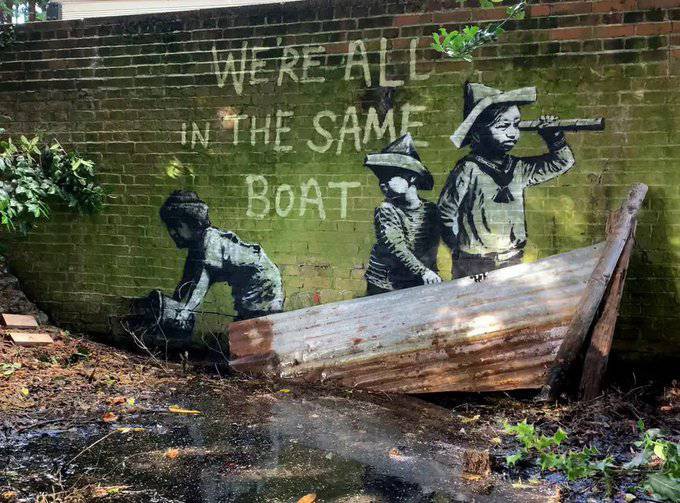Literature reviews: start (and end) with ‘why?’
Starting our series of posts around urban studies research and pedagogical alternatives post-2020, we have our very own Ian Babelon again with us. This first article is focused on his observations and insights around literature reviews that start and end with 'why'. We are confident this series of literature reviews will give you much material for debate and application into pedagogy, particularly for PhD students.
The post was initially published on the slow urban blog on 2 September 2022.
Introduction
Literature reviews are part and parcel of every research project. They are tremendously helpful because they allow you to map out the state-of-the-art in any specific domain. Whether one loves them, hates them, or remains sublimely indifferent to them, researchers must perform literature reviews ad vitam eternam (i.e. as long as they remain researchers). Unless, of course, one can dutifully delegate the tricky task to others, such as research assistants or PhD students. However, the facile compulsion to 'delegate' does not typically match the predicament of most PhD students or early-career researchers, who often have to do most, if not all, Iof the work themselves.
This post introduces a series of articles about the place of literature reviews within knowledge management for spatial planning, particularly concerning the local climate transition. The content will be both practical and philosophical. Practically, the articles will provide a pragmatic strategy and suggestions of tools to perform quality literature reviews that meet your needs while beating information overload. Philosophically, the insight will engage with research to engage with the world, particularly what that means for spatial planning in the Anthropocene. The insight will benefit people who do literature reviews in a research context, whether academic, policy-driven, market-oriented or a mix thereof.
Start (and end) with 'why'
What better way to start a new endeavour than by asking: "why?". The question 'why' is where everything starts and ends. In academic parlance, this typically translates as the sacrosanct 'contribution to knowledge'. In plain language, this can be translated bluntly as: "So what?". Perhaps the existential predicament of all research is the capacity to justify itself. I investigate this in terms of what planning does, or should/would/could do, particularly as related to the climate emergency. In the series of upcoming articles, I locate literature reviews into a broader knowledge management strategy which provides both scaffolding and suggestions of tools to help plan for a 'cooler' planet. A cooler planet could be more 'urbane' (inclusive, attractive, healthy, age-friendly, regenerative, sustainable, and globally much more 'civilised' and well-mannered). A 'cooler planet' could also be more welcoming and generally 'fun' or 'hip' to inhabit. Conversely, a Blade Runner-like planet plagued by ecological collapse and radioactive fallout wouldn't be so 'cool' at all, although the science fiction films and the complex novel on which the films are based are indeed captivating. The articles weave in insight from science fiction for the art of fictional future telling, which can safeguard us against unchecked ideology and question us as to why we choose to do anything in the first place. As we know from policy, academia, activism, and market-led industries, specific choices often have far-reaching, unintended consequences for everyone, for better or worse.
The capacity to ask and provide a tentative answer to 'why?' is the premise to any trustworthy strategy. Why are you doing the research? Why do you seek to do a literature review on a particular topic? Academic coach Andy Stapleton also lays this out in his 5-step literature review process, as echoed by countless researchers. Any proper research endeavour typically starts out with a good old research question. For those doing a PhD, this single most important question will shape the whole journey, and influence the final outcomes of the VIVA / PhD defence. Therefore, the scope of the research question should naturally determine the scope of the literature review. The 'why' will determine the 'what', 'how', 'who', and the supporting 'when' and 'where'. In terms of achieving resilience in the built and natural environment, these questions are not nice to ask, they are fundamental (Meerow & Newell, 2016).
Sounds simple, right? Well… an unfavourable journal peer review process, or comments from your principal supervisor or PI, might sometimes make you think otherwise. The ability to articulate a crystal-clear, well-scoped research question is particularly difficult, in my experience, in the case of research projects that search their tail. Which tale will you tell your audience if you never know where it starts, not mention where it ends? Anything from seemingly small technical hiccups to a full-blown global pandemic can atomise your well-crafted research question, and everything that flows from it. One often likes to think of projects in a linear, waterfall fashion. The 'ideal' PhD journey is typically just that: an ideal-world linear path where a confirmed research proposal is then followed by a thorough literature review to inform data collection and analysis, to be reported upon, discussed and defended within the confines of a thesis and examination. In this pristine theoretical view of the otherwise unwieldy world we live in, the 'why' should typically remain consistent throughout the research journey, and the stars always naturally align to give us the data and feedback we need just as we need them to complete the thesis and defend the VIVA with great bravado. Since everything is theoretically so predictable, we are naturally destined to complete the thesis and defend the VIVA with great bravado. Or so the ideal story goes, reinforced by the linear milestones imposed by research institutions, because after all so many PhD students of the past have gone lightyears into outer space and never came back
More often, however, research projects are fuzzy, unwieldy, and messy, and encounter many hurdles. Uncertainty will make the narration of research projects a skilful art of rewriting history, rather than recounting a predictable plot. Research leads you off the beaten track and into mires and brambles, not to mention dragon lairs. Getting lost repeatedly in the wilderness, in the weeds or in translation, may leave you to ask 'how' the project went off track in the first place, and make you forget the 'why' of it all. I suggest re-reading George Orwell's enlightening 1984 – as inspiration about how to adopt a pragmatic, guilt-free strategy about what it takes to recount past, messy events in a simple, coherent manner. Research outputs typically portray the linearity of a research process rather than its soul-searching aspects, unless one adopts auto-ethnography as core research method. Omitting the messiness could feel like twisting the truth for those perfectionist researchers out there, which I suspect are the overwhelming majority. And certainly, the global COVID-19 pandemic has had the effect of shaking up the 'why' of the PhD journey for many people I know.
Because research projects can be thrown out of balance in mid-course for various reasons, the trick is to develop a new research strategy and set of research questions that can save the ship from capsizing. A robust initial strategy will be flexible enough to adapt research questions as required. Call it 'resilience', which is an essential transferable skill for individuals and communities alike. Knowing how to flex the 'why' of your research, as needed, will determine how well you can tweak the supporting literature review to meet the aims and requirements of the research project. In short, research is often about learning to bounce back while saving face. A pinch of good humour also helps to leave a good impression on others, even as you step out of the pit you had perhaps made yourself.
Because the subject matter of spatial planning is typically 'wicked', as we know at least from when Rittel and Weber (1973) popularised the term, one may have to reframe, or even figure out, the why at the very end of a research project. It may be like reading some great literary classics, where the plot and details are not always explicitly spelled out, and some guess work and interpretation might be left to the reader. Grounded theory, for example, might not be the best candidate for rigid hypothesis-testing or starting out with a well-structured research question. If one carefully watches business anthropologist Simon Sinek's own performance narration about why 'why' matters so much for all manners of enterprises, it is clear that putting on a good show is just as important as the subject matter, should one want to leave a good impression on the audience. This is the age-old adage that both form and content matter: great form without content is just glitter, while great content without appealing form is as good as dead. By analogy, the impactful truth about the 'why' lies as much in how one conveys it, as in what you think it is.
This is why one should not only start with 'why', but also end with it. Doing so can ensure one checks for any incongruencies between the two. Peer-reviewers, VIVA examiners, publishers and research sponsors will likely be on the lookout for patchy explanations since it's their job to pull at the loose ends. Documenting the 'why' process transparently and clearly is also good practice, mainly for yourself, so you may not what to say and what to omit to tell a story that sounds plausible and meets the requirements of the research project at hand. Especially, telling more than you need can open up a whole can of worms for whoever might be suspicious about the 'how', if not the very 'why'. Such might be the art of research-based storytelling.
Planning a literature review for spatial planning
There is something resolutely recursive about planning literature reviews for spatial planning. In this series of articles, I suggest that such recursiveness revolves around strategy, conflict management, and information overload. These three categories subsume many other considerations, and are meant to be indicative of the ways in which literature reviews can engage with their subject matter both substantially and methodologically. This article focuses on strategy as a core component of literature reviews about spatial planning, of what spatial planning as a discipline typically does, relative to other more narrowly specialised disciplines. In the next article, I will discuss a similar approach to conflict management and information overload. The following discussion about strategy weaves together considerations about research methods, spatial planning as a discipline, and the corporate world. It particularly helps to clarify the 'why' of doing literature reviews as the world wakes up to the climate emergency.
Planning with a strategy
Strategy-wise, it is best to start with general considerations. Andy Stapleton's five-step process goes as follows: 1. Get crystal clear on your research questions → 2. Create a 'best guess' structure of the main topics for your field, that will inform your search → 3. Search and catalogue the literature → 4. Formulate the details of your review structure → 5. Get writing!
Similarly, Hannah Snyder provides a four-step plan: 1. Design the review – the 'why': is it needed? what's the contribution, research questions…? Etc. → 2. Do the review: test and refine the search terms, capture the collected literature → 3. Analyse: extract the relevant information and document the process → 4. Write the review, including how you did it, so others could replicate it. This approach is valid irrespective of which 'type' of literature review you do (more on that in the other blog articles in the series).
In the early stages of the literature review, it also pays to make a thematic concept map, which one can refine as one reads more literature (D. J. Creswell & Creswell Báez, 2020). This can help create a comprehensive overview of the domain, which one can then use to narrow or broaden one's scope for the literature review and indeed the wider research design.
These 12 landmark books and other resources about qualitative research shared by Viktorija Prilenska can be particularly helpful in helping you clarify the 'why', 'what' and 'how' for your literature review and wider research design. Additionally, a number of excellent resources about mixed methods could also be immensely useful (see particularly: Amaratunga, Baldry, Sarshar, & Newton, 2002; J. W. Creswell & Creswell, 2018; Flick, 2018; Onwuegbuzie & Leech, 2005; Yin, 2014; Yin & Heald, 1975).
Looking more broadly, these excellent resources may also help you shine as academic researcher.
There is no shortage of resources available that will help craft a robust research strategy and supporting literature reviews. As we are meant to know, this implies opting for a particular paradigm, be it qualitative or quantitative, or a careful, pragmatic mix thereof. Accordingly, different research questions lend themselves to particular research approaches, methods and theories. If one views the world in Boolean terms (i.e. True/False, 1/0), the collected data will naturally become more 'machine-readable'. On the other hand, an experience of the world as inherently nuanced and interpretive will lead one to adopt more constructivist or realist research methods and worldviews. Whichever mode of research one favours, researchers should not try to hide behind hidden assumptions that will falsely justify their chosen approach. I trust those who read the Hitchhikers' Guide to the Galaxy by Douglas Adam that they already know the answer to everything there is to know, which is the two-digit number '42'. How can I find the latest landmark paper in my research topic? "42!". The trouble, so I have hard, is that no one actually remembers the initial (research) question.
There is no end to the messiness and complexity of the real world of people, feelings, concepts, and experiences of the world. When did people ever stop creating the numbers that help generate abstractions of reality? And when did complex mathematical and geospatial patterns beyond intellectual understanding ever stop to shape human experience? Is there any middle ground between so-portrayed objective realities and socially constructed ones, and are they even different realities or just the same seen from different angles? The best we can probably do is provide best guesses and suggestions as to how the issues we investigate could be resolved for the better, rather than for worse. The information and knowledge we gather from the literature should therefore inspire and help us make our own smalls breakthrough in that direction.
For the spatial planning discipline today, one looming issue that affects all sub-domains of expertise is the local climate transition (Jennings, Fecht, & De Matteis, 2020). Arguably, the stakes at hand require action more than methodological or theoretical purity. Lest we should make either interpretivism or (post-)positivism our research religion, we can opt for a more pragmatic way of understanding the world and ourselves that relies on the method(s) and epistemologies that best fit our purposes (Onwuegbuzie & Leech, 2005). The climate emergency, and the long history of imbalances and inequalities that gave rise to it, are wicked and real beyond all scientific or realist abstraction that researchers can devise to justify their careers. It transcends all statistical and interpretive manipulations that humans rely on to restore a semblance of order into an otherwise unpredictable, organic reality that never ceases to unfold and mesmerise us. Our best plan is to give the climate transition our very best shot and sustain that effort both individually and collectively. The evidence base should guide us rather than be an end in itself, even for professional researchers. Centuries if not millennia, of collective investigation, have equipped us with many great tools, data, insight, intuition and advice for more self-conscious 'becoming' (Hillier, 2008). We can use all of these to just 'get on with it'.
We are standing on the shoulders of giants and can benefit from their great achievements and sound advice, but no measure of past experience will cut it for us. We can only learn by doing. The research process may seem deceptively linear when provided with a clear 'plan' or blueprint for doing literature reviews. However, the process is much more likely to be iterative. Especially if one does a literature review for a PhD thesis or a large consortium-led project, the research project could go off course and take on a life of its own for an infinite number of reasons. Rather than a fixed plan, one should devise a robust, flexible strategy.
Planning for literature reviews in domains related to spatial planning should also be grounded in a clear purpose about its intended impact and community(-ies) of practice. For a clearer appreciation of the various communities that could benefit from your research and with which you could engage, it pays to draw inspiration from the compelling work by Wenger (1999). Bluntly put: "So what? Who is it for?" Indeed, a literature review is inseparable from the specific sub-field(s) within which it is embedded. Planning is notably wide in scope and yet encompasses a wide array of specialist, and technical domains, each with its leading experts, ecosystems of tools and policies, and ecologies of professional practice.
It also pays to consider the double meaning of 'strategy' for literature reviews as they pertain to spatial planning proper. One could argue that planning at every spatial scale hardly ever loses its 'strategic' connotation. Even where local development plans and building permits may not fully reflect or embody the orientations of strategic plans and comprehensive plans, the underlying principle remains one of embedded purpose (or intentionality) and some degree of strategic thinking about how one manages the built and natural environment. Accordingly, planning can be constraining in a permissive way: planning permission, building permits, developer contributions, and environmental compensations for development. Planning systems can also be downright oppressive, discriminating against whole segments of society or types of development, sometimes through brutal legal (or semi-legal) enforcement. But development and land use may also manifest as wholly organic or contingent, whereby nothing ever seems 'planned' as such but rather unfolds as a mesmerising mess that may, or may not, sort itself out at any point in time. There are countless examples of 'unplanned' environments worldwide, a proper review of which lies beyond the scope of this article.
Borrowing from corporate strategies to enhance planning
Strategy is also linked to conflict and risk (more on that below). The clear and present danger of conflict only heightens the need for planning and strategy, so the two seem closely interlinked. But while 'strategic planning' seems fundamental to thinking ahead of conflict, analysts from the business world argue the two terms denote discrete activities that are not easily joined up. This is critical if one thinks about the collective value of planning, including what your literature review might state about that. A corporate strategy, Richard Martin argues, denotes "an integrative set of choices that positions you on a playing field of your choice in a way that you win". It implies choosing the right 'playing field' and making it clear how, on that chosen playing field, the company will be great at serving the client base on that playing field in a way that is realistic and coherent across the whole company. 'Planning', on the other hand, is more focused on operations and single project management, with a traditional concern about costs and resource management, which could therefore feel more amenable and 'comfortable'. On the other hand, strategy targets outcomes that are necessarily uncontrollable due to quickly evolving competition and other factors because "you can't prove in advance that your strategy will succeed" which is antinomic to the expected responsibilities of a good project planner. "A strategy is a journey", Richard Martin adds, that should be tweaked as both the market and company evolve. A strategy is best kept simple and provides a general, flexible logic, while plans should lay out the specifics. Strategies are inherently risky, which is why they are not comfortable, but iteration can help better guide the plans that flow from it in a more dynamic way (Airey & Doughty, 2020).
Thankfully, spatial planning and comprehensive planning are nothing like corporate planning or strategy. Local authorities are not influenced by corporate boards of directors, trustees or corporate investors but by elected officials, civil servants, a wide range of constituents, place-based alliances, and influences over decision-making that are not strictly public in nature (Blanco, 2015; Flyvbjerg, 1996). All irony apart, there are perhaps more similarities between corporate and territorial planning strategy than meets the eye – and economic and regional planning are highly complex sub-fields with a wide range of expertise. Also, the dynamics of fierce competition for 'world-class' attractiveness, fuelled by footloose international investment, tourism, migrant labour and the 'creative class', among many other factors, bring strategic planning its distinctive flavour in different places (Jenks, Kozak, & Takkanon, 2008). Neither does strategic planning have to be top-down, as it can also embrace bottom-up dynamics and visioning (Alverti, Hadjimitsis, Kyriakidis, & Serraos, 2016; Carta, 2015).
So it is also with literature reviews, as they are best grounded in the substantive issues that underpin planning and the lived knowledge of the communities of practice that grapple with those issues. It should now be apparent that it is not sufficient to plan. As the next article will discuss, a plan never survives a battle. A strategy, while fuzzier and seemingly nebulous, can lay the ground for greater resilience and adaptability, no matter what the real world throws at us. Furthermore, a participatory approach to strategy-making can be more flexible than a technical plan in that it can perhaps better incorporate bottom-up dynamics earlier on in the planning process (see Kahila-Tani, Kyttä, & Geertman, 2019). This may be difficult in self-directed research projects like PhDs, but remains doable nonetheless, for example using a participatory action-research paradigm.
In sum, strategizing a literature review for spatial planning is a methodological process that is both practical (i.e. planning the literature review as a core research activity) and substantive (doing a literature review about aspects of what planning does, which is always inherently strategic). If you don't have a proper strategy, it might feel like your research just goes on and on, especially if you are struggling to wrap up a PhD. Treating literature reviews as a mere exercise, as something to get done and dusted, robs one of the opportunity to truly engage with the discipline. This includes the need to address and manage inherent conflicts and information overload.
The next articles in the series will address the following topics
- How learning to manage conflicting interests and information overload is paramount for both researchers and spatial planning as a discipline, including how literature reviews can help build such capacity – if at all possible.
- Three main kinds of literature reviews and emerging tools that can help you extract meaning from all the noise.
- A Knowledge Management survival toolkit augmented with suggestions about how to devise your own dynamic productivity system to leverage the best value and impact from reviewing experiences shared in different types of literature.
- Exploratory suggestions about how to write and visualise literature reviews differently, including opportunities to build domain-specific Knowledge Graphs and populating graph database that could broaden the way we use data and share our own expertise through the written and spoken word
Until then, do share your our experience about valuable strategies for literature reviews in any domain related to spatial planning.
References
Airey, J., & Doughty, C. (2020). Rethinking the plannig system for the 21st century. Retrieved from https://policyexchange.org.uk/publication/rethinking-the-planning-system-for-the-21st-century/
Alverti, M., Hadjimitsis, D., Kyriakidis, P., & Serraos, K. (2016). Smart city planning from a bottom-up approach: Local communities' intervention for a smarter urban environment. Paper presented at the Proceedings of SPIE – The International Society for Optical Engineering.
Amaratunga, D., Baldry, D., Sarshar, M., & Newton, R. (2002). Quantitative and qualitative research in the built environment: application of "mixed" research approach. Work study, 51(1), 17-31.
Blanco, I. (2015). Between democratic network governance and neoliberalism: A regime-theoretical analysis of collaboration in Barcelona. Cities, 44, 12-130. doi:10.1016/j.cities.2014.10.007
Carta, M. (2015). Creative City 3.0: smart cities for the urban age. IX. Biennial of European Towns and Town Planners: Smart planning for Europe's gateway cities.
Creswell, D. J., & Creswell Báez, J. (2020). 30 Essential skills for the qualitative researcher: SAGE Publications
Creswell, J. W., & Creswell, D. J. (2018). Research design: Qualitative, quantitative and mixed methods approaches. Thousand Oaks: SAGE Publications.
Flick, U. (2018). Doing triangulation and mixed methods (Vol. 8): Sage.
Flyvbjerg, B. (1996). The dark side of planning: Rationality and "Realrationalität". In S. J. Mandelbaum (Ed.), Explorations in Planning Theory (pp. 383-394). New Brunswick: Rutgers University Press.
Hillier, J. (2008). Plan(e) Speaking: a Multiplanar Theory of Spatial Planning. Planning Theory, 7(1), 24-50. doi:10.1177/1473095207085664
Jenks, M., Kozak, D., & Takkanon, P. (2008). World cities and urban form: fragmented, polycentric, sustainable? New York: Routledge.
Jennings, N., Fecht, D., & De Matteis, S. (2020). Mapping the co-benefits of climate change action to issues of public concern in the UK: a narrative review. The Lancet Planetary Health, 4(9), e424-e433. doi:10.1016/S2542-5196(20)30167-4
Kahila-Tani, M., Kyttä, M., & Geertman, S. (2019). Does mapping improve public participation? Exploring the pros and cons of using public participation GIS in urban planning practices. Landscape and Urban Planning, 186, 45-55. https://doi.org/10.1016/j.landurbplan.2019.02.019
Meerow, S., & Newell, J. P. (2016). Urban resilience for whom, what, when, where, and why? Urban Geography, 1-21. doi:10.1080/02723638.2016.1206395
Onwuegbuzie, A. J., & Leech, N. L. (2005). On Becoming a Pragmatic Researcher: The Importance of Combining Quantitative and Qualitative Research Methodologies. International Journal of Social Research Methodology, 8(5), 375-387. doi:10.1080/13645570500402447
Rittel, H. W. J., & Webber, M. M. (1973). Dilemmas in a general theory of planning. Policy Sciences, 4(2), 155-169. doi:10.1007/BF01405730
Wenger, E. (1999). Communities of practice: learning, meaning, and identity. Cambridge: Cambridge University Press.
Yin, R. K. (2014). Case study research: design and methods. Los Angeles, California: SAGE.
Yin, R. K., & Heald, K. A. (1975). Using the Case Survey Method to Analyze Policy Studies. Administrative Science Quarterly, 20(3), 371-381. doi:10.2307/2391997
Published by Ian Babelon
Ian Babelon is Research Fellow at Northumbria University in Newcastle, UK. His PhD thesis investigates the use of digital tools for public participation in urban planning. Current projects focus on: 1) the potential of 3D city models for collaborative urban planning; 2) net-zero carbon retrofits in social housing. Get in touch with collaboration ideas for consultancy and research projects, and tweet along @IanBabelon.
When you subscribe to the blog, we will send you an e-mail when there are new updates on the site so you wouldn't miss them.








Comments